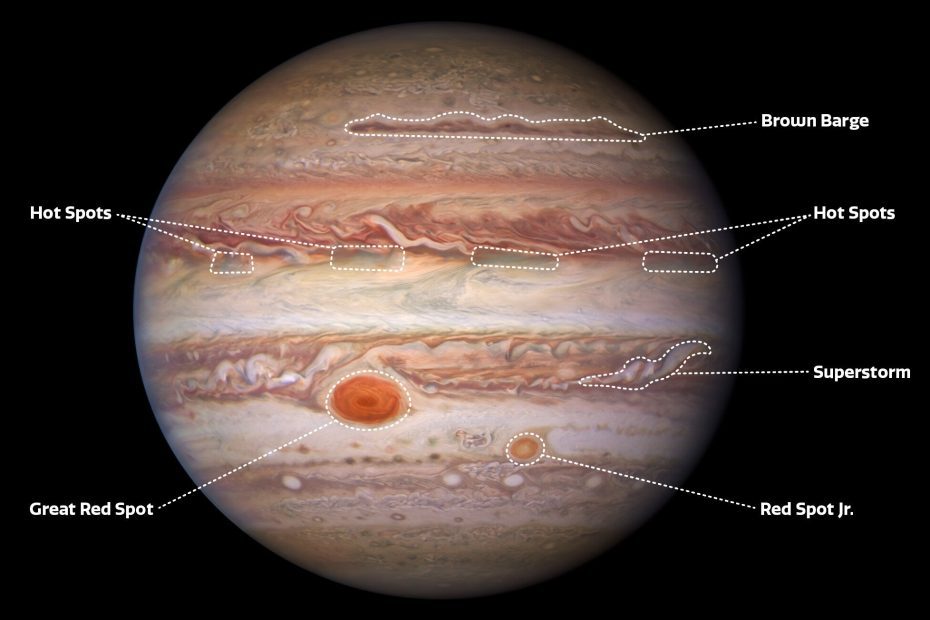Introduction
Among the wonders of our solar system, few features are as instantly recognizable as Jupiter’s Great Red Spot (GRS). This colossal storm has swirled across the planet’s atmosphere for centuries, larger than Earth itself and tinted with a reddish hue that has captivated astronomers since its discovery. Modern spacecraft and telescopes continue to peel back its mysteries, offering fresh insights into its structure, chemistry, and future.
What Is the Great Red Spot?
The Great Red Spot is a giant anticyclonic storm in Jupiter’s southern hemisphere. Unlike terrestrial hurricanes, which form from warm ocean waters, the GRS is powered by Jupiter’s dynamic atmosphere, driven by internal heat and rapid rotation.
- Size: At its largest recorded extent, the storm was over 40,000 km wide, nearly three times Earth’s diameter. Today it has shrunk to about 16,000 km across, still large enough to swallow our planet.
- Rotation: The storm rotates counterclockwise with a period of about 6 Earth days.
- Altitude: The GRS towers several kilometers above the surrounding cloud tops, reaching into Jupiter’s upper troposphere.
- Age: Historical records suggest the storm has been present for at least 350 years, possibly much longer.
Recent Observations
In recent years, high-resolution data from missions and telescopes have provided remarkable details:
- Juno Mission Flybys
NASA’s Juno spacecraft, orbiting Jupiter since 2016, has passed directly over the Great Red Spot multiple times. Using its Microwave Radiometer (MWR), scientists discovered that the GRS extends hundreds of kilometers deep into the atmosphere, far deeper than previously thought. This indicates that the storm is not just a surface phenomenon but a deeply rooted atmospheric system. - Color and Chemistry
Spectroscopic studies suggest the red coloration may result from photochemical reactions in Jupiter’s upper atmosphere. Sunlight interacts with compounds such as ammonia and acetylene, producing complex organic molecules or “chromophores” that give the storm its reddish tint. The exact chemistry, however, is still debated. - Shrinking Storm
Observations from Hubble and ground-based telescopes show that the GRS has been steadily shrinking over the last century. In the late 1800s, its length was about 40,000 km; today it measures closer to 16,000 km. Though smaller, the storm appears to be growing taller and more intense vertically. - Energy Dynamics
Fresh insights suggest that the GRS is powered by surrounding jet streams and small vortex mergers. Smaller storms sometimes crash into the Red Spot, transferring energy and maintaining its longevity. These collisions can alter its shape and even “shave off” parts of its outer layers, but so far the storm has survived.
The Science Behind the Spot
The GRS is an anticyclone, meaning it rotates opposite the planet’s general atmospheric circulation at that latitude. Its persistence is linked to several factors:
- Jupiter’s Lack of Solid Surface: Unlike Earth, Jupiter has no landmasses to break up storms. This allows cyclones to persist much longer.
- Abundant Energy Source: Jupiter emits more heat from its interior than it receives from the Sun, providing a steady energy supply for atmospheric activity.
- Stable Jet Streams: Powerful east–west jet streams flank the GRS, confining it to a specific latitude band and preventing dissipation.
Fresh Insights and Theories
- Storm Depth and Structure
Juno revealed that the GRS is deeper than expected, possibly up to 300 km into the atmosphere, far beyond cloud level. This depth implies a massive reservoir of energy. - Why the Color Is Red
A leading theory is that ultraviolet sunlight triggers chemical reactions in ammonia ice and hydrocarbons, forming reddish compounds. Some models suggest that the storm’s rising motion lifts materials higher than elsewhere, where they are “cooked” by sunlight into red hues. - Longevity vs. Shrinkage
While shrinking in width, the storm shows signs of maintaining strength through vertical growth and ongoing energy absorption. It may not be dying but evolving into a different configuration. - Impact of Smaller Storms
Each year, astronomers watch smaller white ovals and storms slam into the GRS. Sometimes the Red Spot engulfs them, absorbing their energy. These events provide clues about how turbulence feeds long-lived systems.
What the Future Holds
Will the Great Red Spot vanish within our lifetimes? Scientists are cautious. While its shrinking trend is undeniable, its resilience has surprised observers for centuries. Some possibilities include:
- Gradual Dissipation: The storm could eventually break apart if energy sources weaken.
- Transformation: It may stabilize into a smaller but more intense vortex.
- Long-Term Survival: As long as Jupiter’s atmosphere remains active, the GRS or a successor storm may persist for centuries more.
Why It Matters
Studying the Great Red Spot isn’t just about Jupiter—it’s about planetary weather in general. Insights gained help us:
- Understand atmospheric dynamics on other gas giants like Saturn, Uranus, and Neptune.
- Refine models of extreme weather systems, with applications to Earth’s hurricanes and cyclones.
- Explore the chemistry of giant planets, which may resemble conditions in exoplanet atmospheres.
Conclusion
The Great Red Spot remains one of the solar system’s most iconic and enigmatic features. Thanks to spacecraft like Juno, as well as powerful telescopes on Earth and in orbit, astronomers are finally uncovering its secrets. Far from being a static relic, the Red Spot is a dynamic, evolving storm, offering a living laboratory for planetary science. Each new observation reminds us that even familiar features of our cosmic neighborhood still hold mysteries waiting to be unraveled.
